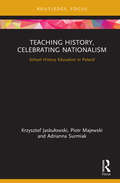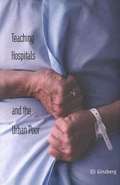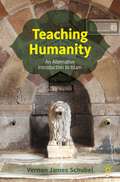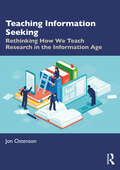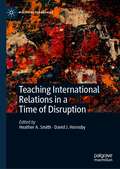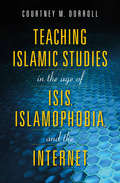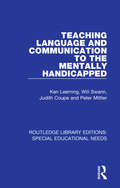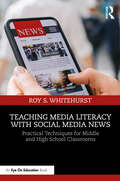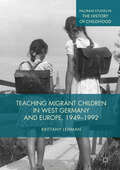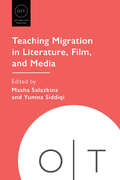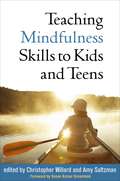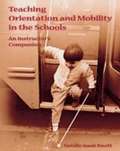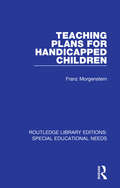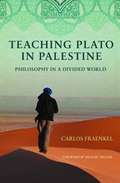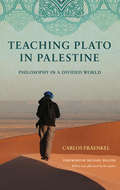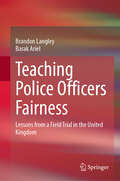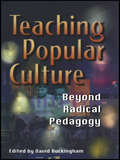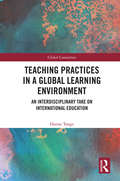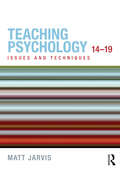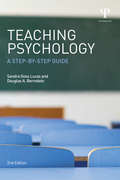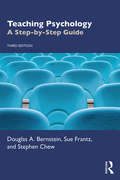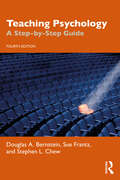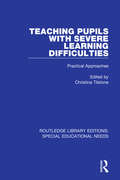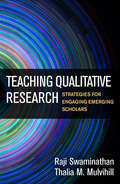- Table View
- List View
Teaching History, Celebrating Nationalism: School History Education in Poland
by Krzysztof Jaskułowski Piotr Majewski Adrianna SurmiakThis book analyses the relationship between history education and nationalism in the context of the dominant structures of collective memory in Poland. Drawing on original qualitative research with history teachers, it explores the ways in which teachers understand the aims of history teaching and how they teach history, with some contesting or negotiating official and hegemonic nationalist memory projects, while others predominantly reproduce or radicalise them. A study of teachers’ tendencies to approach history through the prism of nationalism, this study reveals a view of history lessons as a means of instilling national identity in students, as the past is constructed in nationalist terms and no contradiction is identified in viewing history as both an objective science and a ‘nationalising’ tool. An examination of the means by which a dominant nationalist discourse is reinforced through historical education, Teaching History, Celebrating Nationalism will appeal to scholars of sociology and education with interests in nationalism and memory studies.
Teaching Hospitals and the Urban Poor
by Eli GinzbergAcademic health centers (AHCs) have played a key role in propelling the United States to world leadership in technological advances in medicine. At the same time, however, many of these urban-based hospitals have largely ignored the medical care of their poor neighbors. Now one of the leading experts in American health policy and economics ponders whether current and proposed changes in the financing and delivery of medical care will result in a realignment between AHCs and the poor. Basing his discussion on an analysis of the nation's twenty-five leading research-oriented health centers, Eli Ginzberg and his associates trace the history of AHCs in the twentieth century. He claims that AHCs are once again moving toward treating the poor because these hospitals need to admit more Medicaid patients to fill their empty beds, and their medical students need opportunities to practice in ambulatory sites. He also assesses some of the more important trends that may challenge the AHCs, including financial concerns, changing medical practice environments, and the likelihood of some form of universal health insurance.
Teaching Humanity: An Alternative Introduction to Islam
by Vernon James SchubelThis book introduces Islam through a "humanistic" lens, by highlighting the affective traditions and expressions associated with Sufism and Shi'ism. While most introductory books emphasize the shari’a, and especially the “Five Pillars,” as the primary defining characteristic of Islam, Vernon James Schubel provides an alternative introduction which instead underscores the importance of humanity and the human being within Islamic thought and practice. The book stresses the diversity of Islamic beliefs and practices, presenting them as varied responses to the shared multivalent concepts of tawhid (the unity of God), nubuwwa (prophecy) and qiyama (the Day of Judgment). Readers are introduced to essential aspects of Islam including the life of the Prophet Muhammad, the Qur’an, the development of the shari‘a, and the emergence of the Sunni, Shi‘a and Sufi traditions. The book concludes with a call to redefine “mainstream” Islam, as a religious tradition focused on the centrality of love and rooted in the importance of humanity and universal human virtues.
Teaching Inclusive Education through Life Story Inquiry
by Margo Horne-Shuttleworth Monique Somma Kathy Ann WlodarczykThis practical textbook is designed as core reading for pre-service and in-service teachers and mental health practitioners in upper level Education and Psychology programs. Key concepts addressed in this case study collection include Inclusive Education as an overarching framework through the lens of Critical Disability Studies, Intersectionality and Mental Health. It portrays the first-hand accounts and lived experiences of individuals with disabilities to further understand the impact students’ classroom experiences have beyond their early school years. These accounts along with commentaries from education and health professionals inform evidence-based recommendations for educators and practitioners on prevention and intervention practices for school age children with disabilities. Readers will be prompted to consider their experiences and perspectives through chapter specific discussion-based and reflective questions that are designed to incorporate key concepts addressed throughout the text.
Teaching Information Seeking: Rethinking How We Teach Research in the Information Age
by Jon OstensonTeaching Information Seeking redefines how we approach research and information literacy in today's information-rich world, inviting teachers to re-imagine teaching research.The book combines insights from fields such as library and information sciences, journalism, and media literacy to offer fresh strategies and perspectives for guiding students through evolving landscapes of information.While a focus on concepts and skills has long been important in teaching research, this book integrates significant new understandings about the role dispositions play in how well students embrace and utilize skill-based knowledge. The book provides conceptual knowledge and learning activities that support writing teachers as they help students learn throughout the research or inquiry process of asking questions, finding information, and sharing their learning purposefully and ethically. Chapters with a pedagogical focus and approach include activities informed by the author’s decades of experience teaching writing. These activities are described in depth, including assignment prompts, sample work, and scripts for think-aloud protocols and discussions the author has led that engage students in deeper learning around these critical skills and dispositions. Teaching Information Seeking serves as a comprehensive guide for educators looking to foster meaningful information literacy and critical thinking skills in their students.This book is ideal for teachers and teacher educators who want to equip students with the skills and dispositions needed for effective research and information literacy. Readers will find teacher-friendly, research-grounded insights and activities that can be readily applied in the classroom.
Teaching International Relations in a Time of Disruption (Political Pedagogies)
by David J. Hornsby Heather A. SmithThis volume asks how we, as International Relations scholars, support our students, and indeed each other, to create classroom spaces that foster the critical curiosity and engagement required to understand and live in a world that feels dangerously disrupted? In an era of globalization, disruption, and pandemic, International Relations educators need to reflect upon how teaching helps constitute the discipline and position our students to contribute to the advancement of International Relations as a discipline and practice. Through exploring innovative approaches to teaching and learning, this volume ensures that International Relations keeps up with the contemporary needs of students and student learning, and takes advantage of the opportunity to advance as a discipline now and in the future. As we move through ‘pivots’ online and ‘transitions’ to remote learning in the midst of a pandemic, the need for attention to student learning is only made more prescient and urgent.
Teaching Islamic Studies in the Age of ISIS, Islamophobia, and the Internet (Encounters: Explorations in Folklore and Ethnomusicology)
by William Maynard Hutchins Kecia Ali Todd Green Kimberly Hall Doaa Baumi Manuela Ceballos Nathan S. French Shehnaz Haqqani Benjamin Geer Mouez Khalfaoui Alfons H. Teipen Laila Hussein Moustafa Sabahat F. Adil Phil Dorroll Lyndall Herman&“A much-needed volume and a must read&” for educators addressing a challenging topic in a challenging time (Choice). How can teachers introduce the subject of Islam when daily headlines and social-media disinformation can prejudice students&’ perception of the subject? Should Islam be taught differently in secular universities than in colleges with a clear faith-based mission? What are strategies for discussing Islam and violence without perpetuating stereotypes? The contributors of Teaching Islamic Studies in the Age of ISIS, Islamophobia, and the Internet address these challenges head-on and consider approaches to Islamic studies pedagogy, Islamophobia, and violence, and suggestions for how to structure courses. These approaches acknowledge the particular challenges faced when teaching a topic that students might initially fear or distrust. Speaking from their own experience, they include examples of collaborative teaching models, reading and media suggestions, and ideas for group assignments that encourage deeper engagement and broader thinking. The contributors also share personal struggles when confronted with students (including Muslim students) and parents who suspected the courses might have ulterior motives. In an age of stereotypes and misrepresentations of Islam, this book offers a range of means by which teachers can encourage students to thoughtfully engage with the topic of Islam. &“Abundant and useful references…Highly recommended.&”—Choice
Teaching Language and Communication to the Mentally Handicapped (Routledge Library Editions: Special Educational Needs #35)
by Peter Mittler Will Swann Judith Coupe Ken LeemingFirst published in 1979. This report offers a working model for the teaching of language and communication to the mentally handicapped which derives from both theory and practice, and tries to build a bridge between them. It provides detailed examples of teachers putting principles into action and illustrates how teachers and children work together. The report will be of interest to all those concerned with the welfare of the handicapped child, including the parents. It provides both a working text for teachers, and a basis for critical discussion about curriculum development and content in special needs schools.
Teaching Media Literacy with Social Media News: Practical Techniques for Middle and High School Classrooms
by Roy S. WhitehurstFeaturing tools, activities, and insightful stories from a CIA analyst and instructor with 30+ years’ of experience, this practical and engaging book supports busy educators to teach the lifelong skills of news and media literacy to their students.Based on existing curriculum and teaching standards, this guidebook shows how social studies and English language arts (ELA) teachers can build students’ confidence with social media evaluation skills, which are critical to engaging in civic discourse and building a stronger democracy. In Part 1, Whitehurst gives an overview of the media evaluation techniques based on those you would learn as a CIA analyst, including understanding how our biases and mindset make us vulnerable to disinformation, learning how media tries to persuade us, checking facts, and spotting disinformation. Part 2 dives deeper by showing teachers how learners can check if an argument on social media is valid, and how fallacies and manipulation tactics in online arguments can complicate this important skill. It is illustrated by examples from social media and contemporary popular culture in different mediums, including videos, photos, memes, and AI-generated content. You can also find fresh and updated social media examples on the author’s website, News Literacy Sleuth.Packed with practical classroom resources, examples from popular culture, and engaging insights into the CIA analyst role, this book is designed to support middle and high school teachers with news and media literacy in social studies, civic education, and ELA.
Teaching Migrant Children in West Germany and Europe, 1949–1992 (Palgrave Studies in the History of Childhood)
by Brittany LehmanThis book examines the right to education for migrant children in Europe between 1949 and 1992. Using West Germany as a case study to explore European trends, the book analyzes how the Council of Europe and European Community’s ideological goals were implemented for specific national groups. The book starts with education for displaced persons and exiles in the 1950s, then compares schooling for Italian, Greek, and Turkish labor migrants, then circles back to asylum seekers and returning ethnic Germans. For each group, the state entries involved tried to balance equal education opportunities with the right to personhood, an effort which became particularly convoluted due to implicit biases. When the European Union was founded in 1993, children’s access to education depended on a complicated mix of legal status and perception of cultural compatibility. Despite claims that all children should have equal opportunities, children’s access was limited by citizenship and ethnic identity.
Teaching Migration in Literature, Film, and Media (Options for Teaching)
by Yumna Siddiqi Masha SalazkinaPeople migrate to seek opportunities, to unite with family, and to escape war, persecution, poverty, and environmental disasters. A phenomenon that has real, lived effects on individuals and communities, migration also carries symbolic, ideological significance. Its depiction in literature, film, and other media powerfully shapes worldviews, identities, attitudes toward migrants, and a political landscape that is both local and global. It is imperative, then, to connect the disciplinary and theoretical tools we have for understanding migration and to put them in conversation with students' experiences.Featuring a wide range of classroom approaches, this volume brings together topics that are often taught separately, including tourism, slavery, drug cartels, race, whiteness, settler colonialism, the Arab Spring, assimilation, and disability. Readers are introduced to terminology and legal frameworks and to theories of migration in relation to Black studies, ethnic studies, Asian American studies, Latinx studies, border studies, postcolonial studies, and Indigenous studies.
Teaching Mindfulness Skills to Kids and Teens
by Susan Kaiser Greenland Christopher Willard Amy SaltzmanPacked with creative, effective ideas for bringing mindfulness into the classroom, child therapy office, or community, this book features sample lesson plans and scripts, case studies, vignettes, and more. Leading experts describe how to harness the unique benefits of present-focused awareness for preschoolers, school-age kids, and teens, including at-risk youth and those with special needs. Strategies for overcoming common obstacles and engaging kids with different learning styles are explored. Chapters also share ways to incorporate mindfulness into a broad range of children's activities, such as movement, sports, music, games, writing, and art. Giving clinicians and educators practices they can use immediately, the book includes clear explanations of relevant research findings.
Teaching Orientation and Mobility in the Schools: An Instructor's Companion
by Natalie Isaak KnottTeaching Orientation and Mobility in the Schools: An Instructor's Companion offers orientation and mobility (O&M) instructors and professionals working with students with visual impairments insights and advice. The book offers creative instructional methods and practical strategies as well as useful forms and checklist.
Teaching Plans for Handicapped Children (Routledge Library Editions: Special Educational Needs #38)
by Franz MorgensternFirst published in 1981. Teaching handicapped children confronts us with the challenge of having to plan, deliberately and systematically, how to teach a child to look, listen, move, explore, play, relate to others and to understand and speak their own language – all skills which do not normally have to be taught at all. This book, based on a lifetime’s experience of working with handicapped people of all ages, provides a basic understanding of the effects of a handicap on a child’s development.
Teaching Plato in Palestine
by Michael Walzer Carlos FraenkelTeaching Plato in Palestine is part intellectual travelogue, part plea for integrating philosophy into our personal and public life. Philosophical toolkit in tow, Carlos Fraenkel invites readers on a tour around the world as he meets students at Palestinian and Indonesian universities, lapsed Hasidic Jews in New York, teenagers from poor neighborhoods in Brazil, and the descendants of Iroquois warriors in Canada. They turn to Plato and Aristotle, al-Ghazālī and Maimonides, Spinoza and Nietzsche for help to tackle big questions: Does God exist? Is piety worth it? Can violence be justified? What is social justice and how can we get there? Who should rule? And how shall we deal with the legacy of colonialism? Fraenkel shows how useful the tools of philosophy can be--particularly in places fraught with conflict--to clarify such questions and explore answers to them. In the course of the discussions, different viewpoints often clash. That's a good thing, Fraenkel argues, as long as we turn our disagreements on moral, religious, and philosophical issues into what he calls a "culture of debate." Conceived as a joint search for the truth, a culture of debate gives us a chance to examine the beliefs and values we were brought up with and often take for granted. It won't lead to easy answers, Fraenkel admits, but debate, if philosophically nuanced, is more attractive than either forcing our views on others or becoming mired in multicultural complacency--and behaving as if differences didn't matter at all.
Teaching Plato in Palestine: Philosophy in a Divided World
by Michael Walzer Carlos FraenkelTeaching Plato in Palestine is part intellectual travelogue, part plea for integrating philosophy into our personal and public life. Philosophical toolkit in tow, Carlos Fraenkel invites readers on a tour around the world as he meets students at Palestinian and Indonesian universities, lapsed Hasidic Jews in New York, teenagers from poor neighborhoods in Brazil, and the descendants of Iroquois warriors in Canada. They turn to Plato and Aristotle, al-Ghaz?l? and Maimonides, Spinoza and Nietzsche for help to tackle big questions: Does God exist? Is piety worth it? Can violence be justified? What is social justice and how can we get there? Who should rule? And how shall we deal with the legacy of colonialism? Fraenkel shows how useful the tools of philosophy can be--particularly in places fraught with conflict--to clarify such questions and explore answers to them. In the course of the discussions, different viewpoints often clash. That's a good thing, Fraenkel argues, as long as we turn our disagreements on moral, religious, and philosophical issues into what he calls a "culture of debate." Conceived as a joint search for the truth, a culture of debate gives us a chance to examine the beliefs and values we were brought up with and often take for granted. It won't lead to easy answers, Fraenkel admits, but debate, if philosophically nuanced, is more attractive than either forcing our views on others or becoming mired in multicultural complacency--and behaving as if differences didn't matter at all.
Teaching Police Officers Fairness: Lessons from a Field Trial in the United Kingdom
by Barak Ariel Brandon LangleyThis book explores the growing body of research associated with police legitimacy. It reports on a systematic review to trace, evaluate, and synthesize all the results of published police procedural justice training tests. Further, the volume explores, for the first time, the theoretical relationship between training on procedural justice and both officer self-legitimacy and audience legitimacy as outcomes within the context of counterterrorism policing. It evaluates a number of key topics, including: • The effect of police officers’ higher levels of self-legitimacy on how they conduct themselves. • The design, implementation, and management of a national test examining the effect of a bespoke procedural justice training package aimed at stimulating offices inner confidence. • Audience legitimacy scores in the sensitive world of counterterrorism policing. The chapters that follow explore legitimacy theory, procedural justice, and the lesser-known self-legitimacy component. This volume is ideal for law enforcement professionals, policymakers, criminal justice practitioners, and researchers involved in combating terrorism and improving police legitimacy.
Teaching Popular Culture: Beyond Radical Pedagogy (Media, Education and Culture)
by David BuckinghamTeaching about the media and popular culture has been a major concern for radical educators. Yet in recent years, the hyperbolic rhetoric of "critical pedagogy" has come under attack, not only from theoretical perspectives such as feminism, anti-racism and postmodernism, but also in The Light Of Actual Classroom Experience. The Notion That Teachers Might "liberate" students through rationalistic forms of ideological critique has been increasingly questioned, not only on the grounds of its political arrogance, but also because of its ineffectiveness in practice. This book seeks to move beyond the limitations of these debates, and to explore positive alternatives. It contains a broad international range of contributions, covering practice from primary schools right through to higher education. The authors draw on diverse perspectives, including poststructuralism, postmodernism, cultural studies, anti-racism and feminism; yet they share a willingness to challenge radical orthodoxies, and to offer positive practical alternatives.
Teaching Practices in a Global Learning Environment: An Interdisciplinary Take on International Education (Global Connections)
by Hanne TangeThis book examines teaching practices in international education, focusing on two significant meanings of the notion of ‘practice’: the concrete activities used by university lecturers and the role of education as a platform for transferring particular skills or approaches. In addition to discussing techniques involved in programme design, curricular development, course activities, multicultural teamwork and examination, the author explores the idea of the lecturer as an actor communicating practices, considering the role and responsibility of academic staff in the development of successful international education. With attention to the importance of the context of internationalisation, the book draws on research from two major research projects, presenting extensive interview material with teaching staff engaged in international education and projects of internationalisation. Combining the approaches of ‘pragmatism’ and practice theory, as developed by Bourdieu and Schatzki, among others, Teaching Practices in a Global Learning Environment addresses themes including the international-ness of academic disciplines, the biographies of international educators, and language issues emerging in international education. As such, it will appeal to scholars across the social sciences and policy makers with interests in pedagogy, internationalisation and higher education.
Teaching Psychology 14-19: Issues and Techniques
by Matt JarvisTeaching Psychology 14-19 - first published as Teaching Post-16 Psychology - is a core text for all training psychology teachers, as well as experienced teachers engaged in further study and professional development. Taking a reflective approach, Matt Jarvis explores key issues and debates against a backdrop of research and theory, and provides guidance on practical ideas intended to make life in the psychology classroom easier. With an emphasis on the application of psychology to teaching psychology, it clearly and comprehensively covers the knowledge essential to develop as a successful teacher. Key issues considered include: The appeal of psychology and what the subject can offer students The psychology curriculum and advice on how to choose a syllabus Principles of effective teaching and learning Teaching psychological thinking Differentiated psychology teaching Choosing and developing resources Using technology effectively. With a new chapter exploring the role of practical work in the post-coursework era, this second edition considers psychology teaching across the 14-19 age range and has been updated in light of the latest research, policy and practice in the field. Teaching Psychology 14-19 is an essential text for all those engaged in enhancing their understanding of teaching psychology in the secondary school.
Teaching Psychology: A Step-By-Step Guide, Second Edition (Teaching Psychological Science Ser. #6)
by Douglas A. Bernstein Sandra Goss LucasThis volume provides thoroughly updated guidelines for preparing and teaching an entire course in psychology. Based on best principles and effective psychological and pedagogical research, it offers practical suggestions for planning a course, choosing teaching methods, integrating technology appropriately and effectively, developing student evaluation instruments and programs, and ideas for evaluation of your own teaching effectiveness. While research-based, this book was developed to be a basic outline of "what to do" when you teach. It is intended as a self-help guide for relatively inexperienced psychology teachers, whether graduate students or new faculty, but also as a core reading assignment for those who train psychology instructors. Experienced faculty who wish to hone their teaching skills will find the book useful, too.
Teaching Psychology: A Step-by-Step Guide
by Douglas A. Bernstein Stephen Chew Sue FrantzThis thoroughly revised third edition of Teaching Psychology synthesizes the latest pedagogical research on effective teaching and translates it into recommendations for classroom application. It also takes into account the many changes in the teaching landscape that have taken place in recent years. Covering key topics such as planning a course, choosing teaching methods, assimilating technology, and the integration of teaching into the rest of your academic life, this book also includes an abundance of supportive, supplementary content to guide and inform new teachers. This content will also benefit seasoned teachers who wish to reevaluate their current teaching practices and explore new teaching ideas and techniques. Presenting a comprehensive and cutting-edge teaching guide for psychology teachers, this book is a vital resource for those who are training psychology instructors or undertaking a teaching psychology course. It is also a useful text for more experienced faculty looking to update their current teaching practices.
Teaching Psychology: A Step-by-Step Guide
by Douglas A. Bernstein Sue Frantz Stephen L. ChewNow in its fourth edition, Teaching Psychology: A Step-By-Step Guide synthesizes the latest pedagogical research on effective teaching and translates it into recommendations for classroom application. It explores the rapidly changing academic landscape and offers innovative ideas for teaching psychology and creating inclusive classrooms where all students can experience a sense of belongingness and psychological safety.This comprehensive volume covers key topics such as planning a course, choosing teaching methods that promote well-being, diversity and inclusion, assimilating technology (including Artificial Intelligence), and the integration of teaching into the rest of your academic life. The authors include an abundance of supportive, supplementary content to guide and inform new teachers, including their own real-life anecdotes and examples. Fully revised throughout, this new edition analyses updated research on topics such as student evaluations of teaching, establishing the value of your courses, student motivation, and trigger warnings. This edition also features a completely new chapter on teaching psychology abroad and focuses on the goals of post-pandemic teaching, including harnessing the power of online and hybrid teaching environments.Presenting a valuable and cutting-edge guide for psychology teachers, this book is a vital resource for those who are training psychology instructors or undertaking a teaching psychology course. It is also a useful text for more experienced faculty who wish to reevaluate their current teaching practices and explore new teaching ideas and techniques.
Teaching Pupils with Severe Learning Difficulties: Practical Approaches (Routledge Library Editions: Special Educational Needs #54)
by Christina TilstoneFirst published in 1991. This book provides a comprehensive view of the needs of pupils with severe learning difficulties and considers the attitudes of parents, teachers, administrators and the pupils themselves. It offers practical approaches to assessment and curriculum design; the management of the classroom environment; approaches to classroom evaluation; pupils from minority groups; collaboration with other professionals; integration and stress and the classroom teacher.
Teaching Qualitative Research: Strategies for Engaging Emerging Scholars
by Raji Swaminathan Thalia M. MulvihillThis timely resource provides a framework for teaching students how to think qualitatively and become more critical and reflexive researchers. Presented are a wealth of pedagogical tools that instructors across the disciplines can tailor to their own needs, including thought-provoking discussion questions, group work exercises, and field activities. The authors discuss issues and choices in course design, including approaches to assessment and grading, and share sample syllabi for both online and face-to-face course formats. Exploring the complexities and debates that surround teaching qualitative research, the book argues for a holistic model of preparing novice researchers. It demonstrates effective ways to engage students in the qualitative inquiry process from start to finish--from understanding positionality and crafting a research problem to writing up findings for different audiences.
